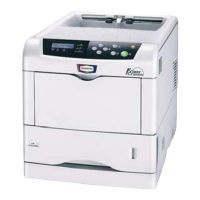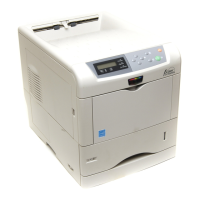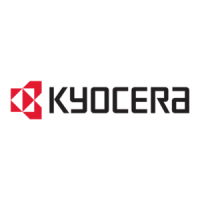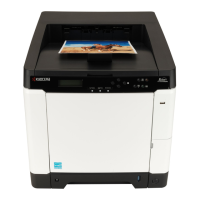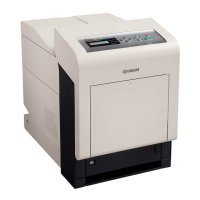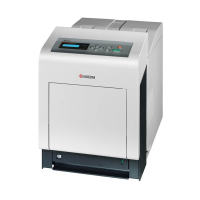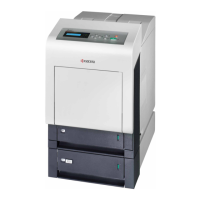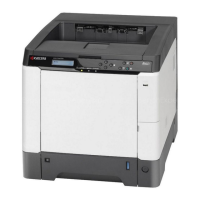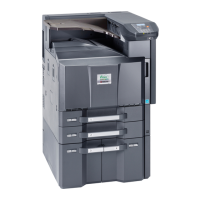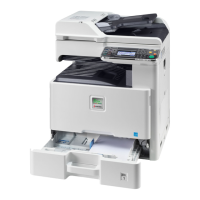Do you have a question about the Kyocera FS-C5400DN and is the answer not in the manual?
Information regarding software compatibility and emulation modes for the printer.
List of registered trademarks and tradenames associated with the printer.
Acknowledgement of typeface licenses from Monotype Imaging Inc.
Terms and conditions for the use of software and typefaces provided by Monotype Imaging.
Statement regarding compliance with FCC Part 15 and RSS-Gen rules.
Details on the printer's Class 1 laser product certification and safety warnings.
Manufacturer's declaration of compliance for the radio frequency transmitter module.
Information on potential restrictions for radio tag technology usage in certain countries.
Compliance with CDRH regulations and advice on ozone gas concentration.
Safety instructions regarding the proper disconnection of the printer's power.
Description of the automatic sleep mode for energy conservation.
Details on the built-in duplex printing capability for paper saving.
Information on the printer's support for recycled paper types.
Statement of compliance with the International Energy Star Program standards.
Guidelines for optimal environmental conditions and site selection for the printer.
Recommended clearance space around the printer for ventilation and maintenance.
Important warnings and specifications regarding the printer's power supply connection.
Safety warning about keeping plastic bags away from children.
Additional warnings for operating the printer and handling components.
Safe practices for handling toner containers and toner powder.
Overview of the operation guide's chapters and the manual's typographical conventions.
Identification and explanation of parts located on the front of the printer.
Identification and explanation of parts located on the left side of the printer.
Identification and explanation of the printer's internal components.
Identification and explanation of parts located on the rear of the printer.
Introduction to the printer's operation panel and its components.
Procedure for configuring network settings such as TCP/IP and protocols.
How to print a status page for confirming printer and network information.
Step-by-step guide for installing the printer driver on a computer.
Instructions for printing documents from various application programs.
Overview and usage of the Status Monitor for checking printer status.
Procedure for removing printer software from a Windows PC.
Important guidelines for selecting and handling paper to ensure optimal printing.
Criteria and recommendations for choosing suitable paper types.
Information on using special papers like transparencies, labels, and envelopes.
Table outlining paper types and their compatibility with printer sources.
Step-by-step instructions for loading paper into the paper cassette and MP tray.
Overview of the operation panel's role in configuring printer settings.
Explanation of the LCD display, indicators, and keys on the operation panel.
Guide on how to use the menu system to access and change printer settings.
Procedures for setting various operational modes through the menu system.
How to print various reports like menu maps, status pages, and font lists.
Instructions for printing files from and managing USB memory devices.
Using Custom Box and Job Box for storing and managing print jobs.
How to view job history logs and page counters.
Detailed settings for paper sources, types, feed modes, and print quality.
Detailed configuration of print parameters including paper, duplex, and quality.
Procedures for setting up TCP/IP, IPv4, IPv6, and network protocols.
Configuration of common device settings like language, buzzer, and display brightness.
Setting up network security, interface blocking, and administrator access.
Managing job accounting, user accounts, and administrator access.
Procedures for adjusting print quality and performing basic maintenance.
Introduction to basic maintenance tasks that can be performed by the user.
Step-by-step guide for replacing toner containers when they are low or empty.
Instructions for replacing the waste toner box when it is full.
Procedures for cleaning internal printer parts, such as the paper transfer unit.
Basic steps and tips for resolving common printer issues.
Solutions for various print quality issues like skewed colors or dropout dots.
Guide to interpreting error messages and taking corrective actions.
Step-by-step instructions for removing jammed paper from different printer locations.
Details on the printer's available interfaces and their functions.
Technical specifications and pin assignments for the USB interface.
Supported network protocols, features, and operating system compatibility.
Information on optional hardware like paper feeders, memory, and hard disks.
Instructions for installing and checking expansion memory modules.
Overview of optional components such as memory cards, paper feeders, and hard disks.
Technical specifications including printing speeds, resolution, and dimensions.
